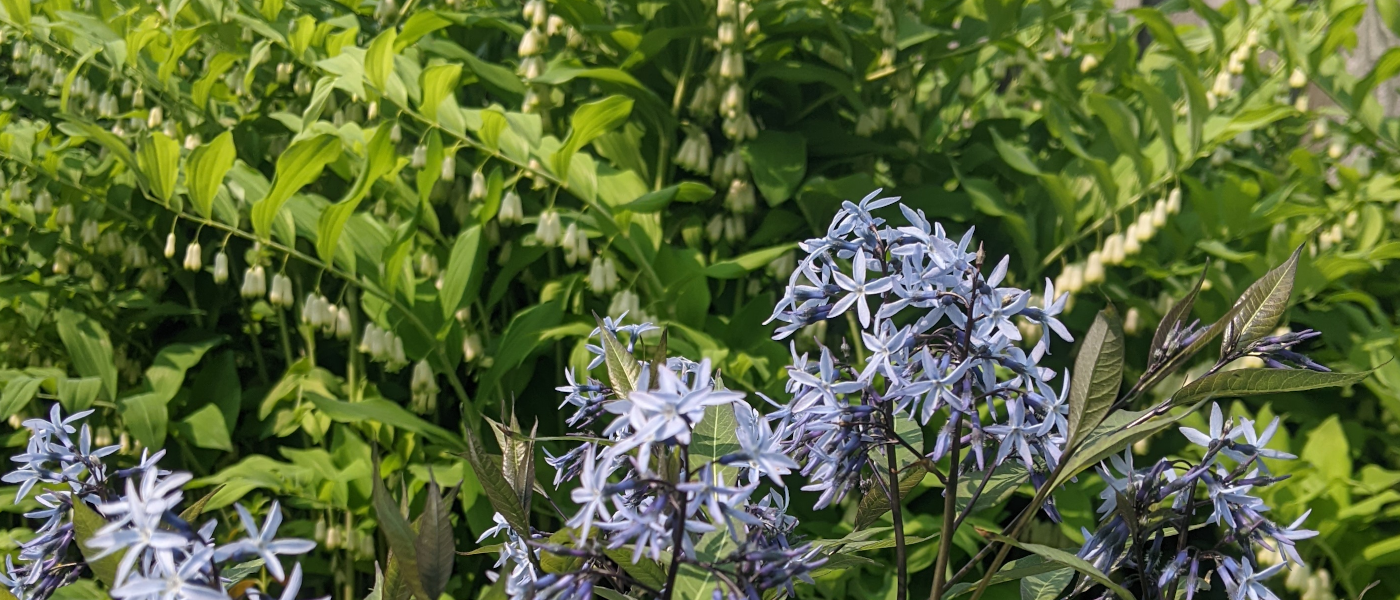Menu

Level Up your Garden to All Season Long
Level Up your Garden to All Season Long
Does your garden have areas that are only in bloom at some times of the season? We often forget that perennials don't bloom for the whole spring-summer-fall season. Even in the best conditions, some only bloom for a few weeks. Part of the enchantment is that short lived beauty. But, some people seem to manage to always have an amazing garden. All. Season. Long.
Here are some tips to help you to achieve that level up.
Take a look around and make some notes
The first step is to take a good look at the parts of your garden that you like and don't like, and remember the seasonality as you do that. Sometimes it's really hard to remember what happens in the other parts of the season. Here's where your phone photos may be a help. I think of several parts of the season. Maybe if I name some plants in each category it could jog your memory.
Spring : this is when bulbs shine in the garden
Hellebores bloom so early, that they should be considered even before spring bulbs. These queens of the early spring garden are ready to bloom as soon as the snow melts. Some people prefer to cut back their foliage so the flowers shine, but I can't bear to remove anything green that early in the season.

Bulbs are usually also separated into early, mid, and late spring categories. But, some years, depending on the weather, those may all get smashed into one glorious free for all bonanza of flowers all at once. In the bulb category I think of
- Crocus
- Tulips
- Daffodils
- Grape hyacinth
- Hyacinth
- Siberian squill (these are really invasive, please don't add these.)
There are also a few native spring bulbs such as
- Trillium
- Spring Beauty
- Trout Lily
- Virginia Bluebells.
- Fringed Bleeding Heart (Dicentra eximia)
- Squirrel Corn (Dicentra canadensis)
- Dutchman's Breeches(Dicentra cucullaria)
Early Summer: Some perennials blooms in the early season.

This is the season of fruit blooms. All of the fruiting trees (apple, pear, cherry), and the fruiting shrubs (haskap, blueberry, raspberry,) bloom in the early summer. Along with those are many early summer garden plants such as
- Old Man's Whiskers(Geum trifolium)
- Bishops Hat (Epimedium)
- Pussytoes (Antennaria dioica),
- Bleeding Heart(Dicentra spectabilis)
- Columbine (Aquilegia)
- Arkansas Blue Star (Amsonia)
- Lady's Mantle (Alchemilla mollis)
- Bearded Iris
- False Indigo(Baptisia australis)
- Peonies. Who doesn't love peonies!
Mid Summer: From July to end of August
This is when we come into the real explosion of colour in most gardens. The great extravaganza!
- Shasta daisies (Leucanthemum)
- Anise hyssop (Agastache)
- Coneflower (Echinacea)
- Yarrow (Achillea)
- Butterfly milkweed (Asclepias tuberosa)
- Beebalm (Monarda)
- Tickseed (Coreopsis)
- Garden Sage (Salvia)
- Cranesbill (Geranium)
- Daylily (Hemerocallis)
- Gayfeather (Liatris)
- Beardtongue (Penstemon)
- Black-eyed Susan (Rudbeckia)
Some of these are, admittedly more towards the beginning of summer, and others towards the end. Who ever said plants fit into neat categories! Deadheading will often extend bloom time for these plants.
Fall: Those late bloomers that can sometimes carry colour right up until frost.

Later in the season, we have lots of plants that are very important to support our insects right up through the colder months. There are so many different asters, there must be one that belongs in your garden! I have New England Asters, and Panicled Asters, and Wood's New York Aster in my own.Late bloomers include:
- Aster
- Anemone (the fall ones)
- Sneezeweed (Helenium)
- Stonecrop (Sedum spectabile)
- Goldenrods (Solidago)
- Blue Leadwort (Ceratostigma plumbaginoides)
- Tutlehead (Chelone)
- Snakeroot (Cimicifuga)
- Montauk Daisy (Nipponanthemum nipponicum).
Don't forget fall foliage colour in your garden plans too. Sundrops, Gayfeather, grasses, hostas, practically give us a second bloom with their fall leaf colours.
Finding Space for new plants
Sometimes I make a list of plants that I want to add. I try to take into account the bloom times of what I have, and the colours I want to complement. But, where can they all go? I have a serious case of plant envy. (Is that a surprise to anyone?) Some of the later sprouting plants (hosta, hardy hibiscus, butterfly milkweed) share space with early blooming plants, particularly bulbs. Just remember to pay attention to root space too. Usually, when I look with a more critical eye, I realize that some of my plants are simply too rambunctious. Thats a good thing when you have a lot of space to cover, but when you are looking at the foliage after those blooms are spent are they taking up too much space? I just edited out a patch of Geraniums to make way for some later blooming beebalm. (I'm excited to try out a new to me Monarda bradburiana). I love black eyed susans, and they haven't bloomed yet, but do I need THAT many? Another common opportunity is that many of the earlier blooming plants are shorter than the ones that will fill in later in the season. There is no one way to deal with this. Some of my plants I do a Chelsea chop (for instance I cut my New England asters in half in early June), sometimes I just plant the shorter ones in front and let the taller ones come up behind them.
Voila.
And, voila, you have the garden of your dreams. I know, it never really works that way. The truth is that our gardens are always a journey, a process, never finished. This, too, is part of the joy of gardening.
- Choosing a selection results in a full page refresh.

